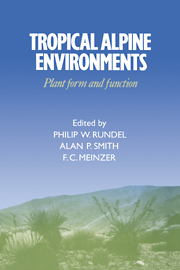Book contents
- Frontmatter
- Contents
- List of contributors
- Preface
- 1 Introduction to tropical alpine vegetation
- 2 Tropical alpine climates
- 3 Páramo microclimate and leaf thermal balance of Andean giant rosette plants
- 4 Comparative water relations of tropical alpine plants
- 5 Cold tolerance in tropical alpine plants
- 6 Anatomy of tropical alpine plants
- 7 Environmental biology of a tropical treeline species, Polylepis sericea
- 8 Morphological and physiological radiation in páramo Draba
- 9 Sediment-based carbon nutrition in tropical alpine Isoetes
- 10 Functional significance of inflorescence pubescence in tropical alpine species of Puya
- 11 Turnover and conservation of nutrients in the pachycaul Senecio keniodendron
- 12 Soil nutrient dynamics in East African alpine ecosystems
- 13 An overview of the reproductive biology of Espeletia (Asteraceae) in the Venezuelan Andes
- 14 Population biology of Mount Kenya lobelias
- 15 Population biology of Senecio keniodendron (Asteraceae), an Afroalpine giant rosette plant
- 16 Population dynamics and flowering in a Hawaiian alpine rosette plant, Argyroxiphium sandwicense
- 17 Plant form and function in alpine New Guinea
- 18 Alpine herbivory on Mount Kenya
- 19 Biotic interactions in Hawaiian high elevation ecosystems
- 20 Tropical alpine ecology: progress and priorities
- Index
3 - Páramo microclimate and leaf thermal balance of Andean giant rosette plants
Published online by Cambridge University Press: 21 October 2009
- Frontmatter
- Contents
- List of contributors
- Preface
- 1 Introduction to tropical alpine vegetation
- 2 Tropical alpine climates
- 3 Páramo microclimate and leaf thermal balance of Andean giant rosette plants
- 4 Comparative water relations of tropical alpine plants
- 5 Cold tolerance in tropical alpine plants
- 6 Anatomy of tropical alpine plants
- 7 Environmental biology of a tropical treeline species, Polylepis sericea
- 8 Morphological and physiological radiation in páramo Draba
- 9 Sediment-based carbon nutrition in tropical alpine Isoetes
- 10 Functional significance of inflorescence pubescence in tropical alpine species of Puya
- 11 Turnover and conservation of nutrients in the pachycaul Senecio keniodendron
- 12 Soil nutrient dynamics in East African alpine ecosystems
- 13 An overview of the reproductive biology of Espeletia (Asteraceae) in the Venezuelan Andes
- 14 Population biology of Mount Kenya lobelias
- 15 Population biology of Senecio keniodendron (Asteraceae), an Afroalpine giant rosette plant
- 16 Population dynamics and flowering in a Hawaiian alpine rosette plant, Argyroxiphium sandwicense
- 17 Plant form and function in alpine New Guinea
- 18 Alpine herbivory on Mount Kenya
- 19 Biotic interactions in Hawaiian high elevation ecosystems
- 20 Tropical alpine ecology: progress and priorities
- Index
Summary
Introduction
General climatic features of tropical alpine regions have been discussed in Chapter 1 of this volume. To reiterate, the nearly complete lack of temperature seasonality in tropical alpine zones is a key feature in distinguishing them from temperate alpine zones. The Andean páramo zone and similar zones in other tropical high mountains are characterized by high inputs of solar radiation in the presence of low inputs of thermal energy. This characteristic might be expected to present special circumstances from the standpoint of regulation of leaf thermal balance, in contrast to temperate alpine and desert habitats where both solar radiation and thermal energy inputs may be seasonally high. It has been suggested that some of the prominent morphological features found in giant rosette plants (see Chapter 1) represent adaptations for regulation of thermal balance under the special microclimatic conditions encountered in tropical mountains (Hedberg 1964; Larcher 1975).
Numerous studies have dealt with the importance of characteristics such as leaf absorptance to solar radiation, leaf angle and rate of transpirational cooling as determinants of leaf temperature under a given set of environmental conditions (Mooney et al. 1977 Geller & Smith 1982). However, fewer studies have examined the interaction between spatial and temporal changes in environmental variables and plant features thought to be important for regulation of leaf thermal balance (Smith & Nobel 1977; Ehleringer & Mooney 1978).
- Type
- Chapter
- Information
- Tropical Alpine EnvironmentsPlant Form and Function, pp. 45 - 60Publisher: Cambridge University PressPrint publication year: 1994
- 10
- Cited by



